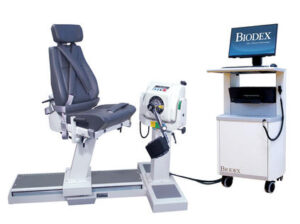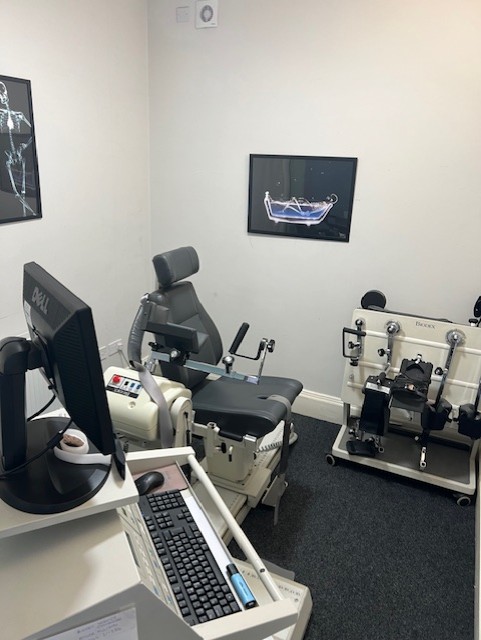The Benefits of Isokinetic Testing in Rehabilitation
In the ever-evolving field of physiotherapy, innovative technologies are constantly emerging to enhance patient care and optimize treatment outcomes. One such breakthrough is isokinetic testing, a sophisticated method for evaluating muscle function and strength. This advanced technology is transforming the way we approach rehabilitation, offering a plethora of benefits for both our clinicians and patients.
What is Isokinetic Testing?
Isokinetic testing involves the use of specialised equipment to measure muscle strength and performance at a constant speed. Unlike traditional methods, isokinetic devices provide resistance that matches the user’s muscle force, ensuring a consistent and accurate assessment. This technology allows for detailed evaluation across various speeds, offering comprehensive insights into muscular health.
Benefits of Isokinetic Testing in Rehabilitation
1. Precise Assessment of Muscle Function
Isokinetic testing provides an objective and detailed analysis of muscle strength and imbalances. By assessing muscle performance at different speeds, our physiotherapists can identify specific areas of weakness or dysfunction. This level of precision is crucial for developing targeted rehabilitation programs tailored to our patient’s needs.
Reference: Dvir, Z. (2004). Isokinetics: Muscle Testing, Interpretation, and Clinical Applications. Elsevier.
2. Customized Treatment Plans
With the data obtained from isokinetic testing, our physiotherapists can design individualised treatment plans. These plans address specific muscle imbalances and weaknesses, leading to more effective and efficient rehabilitation. Customised programs ensure that patients receive the most appropriate interventions, maximising recovery outcomes.
Reference: Tsiros, M. D., et al. (2018). “Customizing Rehabilitation Programs Using Isokinetic Strength Testing Data.” Journal of Strength and Conditioning Research, 32(5), 1373-1380.
3. Enhanced Patient Engagement
One of the key challenges in rehabilitation is maintaining patient motivation and adherence to treatment programs. Isokinetic testing provides clear, visual feedback that helps our patients understand their condition and track their progress. This tangible evidence of improvement fosters greater patient engagement and commitment to their rehabilitation journey.
Reference: Zupan, A., et al. (2011). “The Role of Isokinetic Testing in Enhancing Patient Engagement During Rehabilitation.” International Journal of Rehabilitation Research, 34(3), 231-238.
4. Objective Progress Monitoring
Regular isokinetic testing sessions allow for objective monitoring of our patient progress. By comparing results over time, our physiotherapists can adjust treatment plans as needed, ensuring that their patients continue to receive the most effective care. This data-driven approach enhances the overall quality of rehabilitation and helps achieve optimal outcomes.
Reference: Baltzopoulos, V., & Brodie, D. A. (1989). “Isokinetic Dynamometry: Applications and Limitations.” Sports Medicine, 8(2), 101-116.

5. Reduced Risk of Re-injury
Isokinetic testing not only aids in rehabilitation but also plays a critical role in preventing re-injury. By thoroughly assessing muscle function and addressing imbalances, our physiotherapists can ensure that their patients are fully prepared to return to their daily activities or sports. This comprehensive approach minimises the risk of future injuries.
Reference: Croisier, J. L., et al. (2008). “Isokinetic Testing for Preventing Hamstring Injuries in Soccer Players.” Clinical Journal of Sport Medicine, 18(3), 257-262.
Conclusion
Isokinetic testing is revolutionizing the field of physiotherapy by offering precise, objective, and comprehensive assessments of muscle function. The benefits of this technology extend beyond accurate diagnosis to include customised treatment plans, enhanced patient engagement, and reduced risk of re-injury.
By integrating isokinetic testing into rehabilitation programs, our physiotherapists can deliver more effective, efficient, and personalised care, ultimately leading to better patient outcomes. We are embracing the future of rehabilitation with isokinetic testing and witness the transformative impact on our practice and patients.
References:
- Dvir, Z. (2004). Isokinetics: Muscle Testing, Interpretation, and Clinical Applications. Elsevier.
- Tsiros, M. D., et al. (2018). “Customizing Rehabilitation Programs Using Isokinetic Strength Testing Data.” Journal of Strength and Conditioning Research, 32(5), 1373-1380.
- Zupan, A., et al. (2011). “The Role of Isokinetic Testing in Enhancing Patient Engagement During Rehabilitation.” International Journal of Rehabilitation Research, 34(3), 231-238.
- Baltzopoulos, V., & Brodie, D. A. (1989). “Isokinetic Dynamometry: Applications and Limitations.” Sports Medicine, 8(2), 101-116.
- Croisier, J. L., et al. (2008). “Isokinetic Testing for Preventing Hamstring Injuries in Soccer Players.” Clinical Journal of Sport Medicine, 18(3), 257-262.


